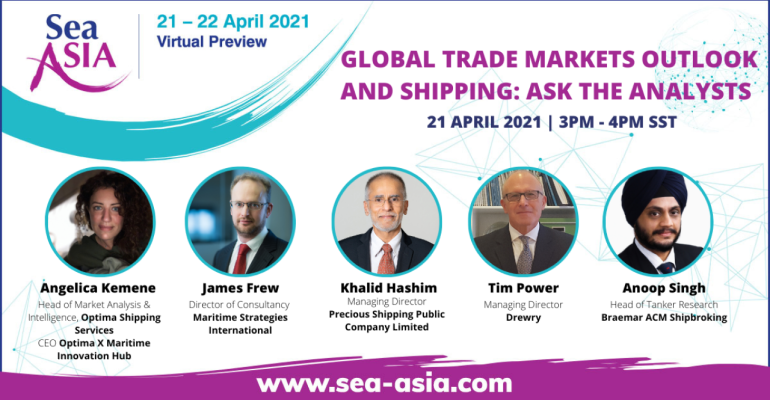Speaking at an ask the analyst session at the Sea Asia Virtual Preview event, Khalid Hashim, managing director of Precious Shipping said the fundamentals for the dry bulk market were very different compared to the post-2009 crash period and the market lows seen in 2016.
Hashim said that the pandemic had made predicting and analysing trade demand incredibly difficult.
Clarksons pegged world dry bulk demand growth at 4.36% for 2021 and while that estimate was higher earlier in the year, Hashim expected it to rise again as the year progressed. That demand growth compares to net fleet growth expected around 1.7%, and a low orderbook to fleet ratio of 5.75%. In the wake of the financial crisis in 2009 the orderbook to fleet ratio was 80.49% and net fleet growth was 9.23%, leading to a period of worsening oversupply, “this time, it’s different,” he said.
In the first quarter of 2021, dry bulk time charter earnings had risen compared to the 10-year average for the first quarter by 85% for capsizes, 98% for panamaxes, 79% for supramaxes and 102% for handy sizes, said Hashim.
Another supporting factor for the dry bulk market in 2020 was a significant stimulus package from Chinese authorities which raised steel demand. In 2021 the market will be supported by global stimulus spending of over $20 trn, said Hashim.
For the container market, Tim Power, Managing Director at Drewry said that 2020 was a wild ride as the pandemic caused supply chain inefficiencies and consumer demand for durable goods rose in the US. The outlook was positive, he said.
“The fundamentals are there for this industry to be sustainably profitable for ever more,” said Power.
The container sector is still recovering from the disruption caused by port delays and equipment shortages, and what happens next is up for debate, said Power. There are signs that the current profitability of container lines will remain through 2022, albeit falling as inefficiencies are worked out, loosening capacity.
“The fundamentals of container shipping until this year have always been rubbish. You have economies of scale which mean overcapacity, you have perishability, high operational gearing… a totally fragmented market and an inelastic demand curve. It’s a recipe for disaster,” said Power.
“That’s now changed. Economies of scale have run out, the industry is more concentrated and now the inelastic demand curve works for you as has been amply demonstrated. The question now is, can the lines mess it up now that the fundamentals are right?”
A return to ego-driven massive ordering and fights for market share could still ruin those improved fundamentals, said Power. MSC has 35 ships on order totalling around 600,000 teu, around a third of the total orderbook capacity. In the past, Maersk would return fire with their own ordering spree, but “they aren’t at the moment. Maybe that’s because they’re saying ‘we are not in the business anymore; we are going to become an integrated logistics player and we’re not just chasing share like the old days’. Let’s see how long that lasts," said Power
The pandemic also had a profound impact on the underlying trade flows for the tanker market, said Anoop Singh, Head of Tanker Research, Braemar ACM Shipbroking.
Singh believed that by the end of this year, demand for oil will outstrip supply from OPEC and lead to the body raising output. This should bring improvements for suezmaxes and VLCCs as increased supplies to the west mean loaded voyages in both directions.
Tanker markets will also feel an early impact of the global energy transition, said Singh, as he believes both US gasoline demand and EU diesel demand have peaked.
“As that demand passes its peaks, we think refining throughput in the US and Europe will continue to decline at a faster rate than crude production changes,” said Singh.
Beyond the short term, Singh expects a mid-decade peak in fuel demand in China, leaving India to take the lead in demand for oil fuels.
James Frew, Director of Consultancy, Maritime Strategies International spoke on the decarbonisation challenge facing the maritime industry. MSI expects LNG to grow in use as a fuel through to 2030 when it will begin to lose market share to zero carbon solutions like ammonia and hydrogen fuels.
Cargoes will also decarbonise, said Frew, with combined cargoes of gas, oil and coal peaking in 2035 before starting a steep descent.
Copyright © 2024. All rights reserved. Seatrade, a trading name of Informa Markets (UK) Limited.
Add Seatrade Maritime News to your Google News feed.  |


